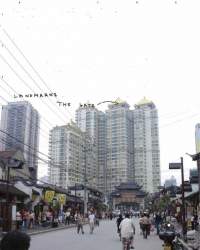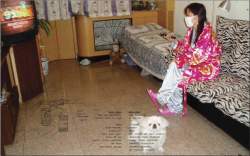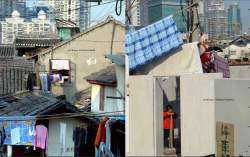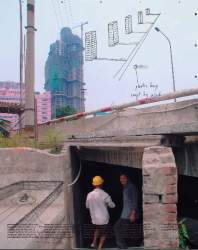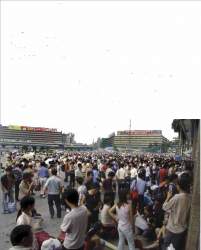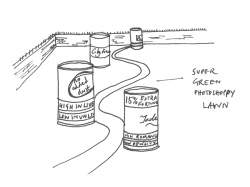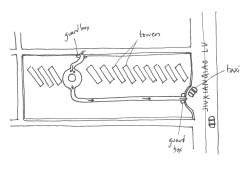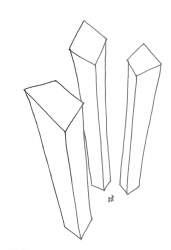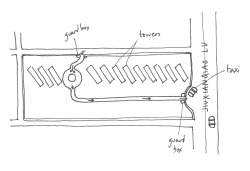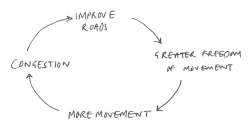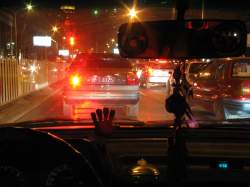Hey, f*ck!
Where'd the city go?
abstract dreaming / pouring concrete
Author: Adrian Hornsby
靠!城市哪儿去了?
Summary
逃离拥挤嘈杂的城市、回归田园牧歌才是高品质生活的要旨,开发商如是说。他们信誓旦旦地要打破城市破败不堪的局面,在都市中另辟郊区田园生活的蹊径。于是他们把在城中兴建的高层与周边环境划清界限,在售楼书上构筑了田园生活的图景。这些炮制出来的“非城市”终究还是成了糟糕的城市的一部分。随着汽车的日益横行,城市中的郊区田园生活不过成了开发商的又一个弥天大谎。我们要思考的是,无论是自上而下的城市规划还是自下而上的市场发展,都无法单独改变城市的宿命。也许只有政府-开发商-设计师-居住者协商的方式,突出连接部分的重要性,才能消除严重的社会分化,让城市的功能升级。
The city is a location for acts of stratification. It is where society goes to organize itself into structures of power. In order to make sense to an individual citizen, the city must speak itself as he wanders through it. It must display certain qualities, and hide others.
At its low points the city doesn’t make sense and starts to feel wrong. Citizens start to think they want to get out — that they don’t like all this stratification, even though they are economically bound to it. They start to feel an anti-urban desire, leading in the twentieth century to the invention of mass suburbia.
Certain harsh qualities of the contemporary Chinese city are in place to produce anti-urban desires, but the conditions around them make traditional one-storey suburbia unlikely. Instead we see a number of high-rise building projects which seem to want to deny the very city they are a part of. They are designed and marketed as islands of non-city in the city, and lead to disruptions in the urban fabric.
In combination with the increasing motorizations of China, these anti-urban forms threaten crude stratification, and a hostile urban environment. We see the emergence of multi-lane highways, with sheet walls to either side. Moving through the city it simply doesn’t seem to be there any more. Neither top-down visionary forms of urban planning, nor bottom-up ideas of organic emergence, are adequate methods to protect the city from such a fate. Instead a public-private partnership will need to be developed, with greater focus on the importance of transitional tissue. In this way the social stratification cities necessarily impose can be made to make produce structures which are less alienating, and offer improved functionality.
城市是阶级的形成地,是社会使其自身组织起权利结构的地方。为了向市民个体展现自己的意义,当市民穿过它的时候,它必须向人们展示自己。它必须表现出一定的质量,同时隐藏一些其他的东西。
在它的低端,城市没有任何意义,而且让人感觉不好。市民们开始想离开城市——因为他们不喜欢所有的这些阶级分层,尽管他们与城市间有着经济上的联系。他们开始产生了反城市化的情绪,这使得20世纪向创建巨型郊区的方向发展。
现代中国城市的某些粗糙方面正在制造着反城市化的情绪,但是他们周围的条件好象并不是在建造传统的平房式的郊区。取而代之的是相当数量的高楼拔地而起,好像要否定它们是城市的一部分。他们被设计并交易作为城市中的非城区, 并且使城市建筑陷入混乱。
与中国正在增长的机动性相融合,这些反城市化的形式威胁着自然形成的阶级分层,以及一个敌对的城市环境。我们看到了立交桥的出现。组织管理严密的空想的城市形式和有组织的显露的颠倒理念,都不是有效保护城市的方法。取而代之的是一个公私合作关系需要被发展,在传统观念的重要性上需要更大的关心。这样,城市社会化的强制执行可以用来制造较少的另类结构,并且提供更好的功能。
“Hey f*ck! Where’d the city go?”
Straining to deny yourself, or, Why our parents all moved to the suburbs
The notion of the city presupposes social stratification. At the moment of its inception, the city is already organizing and selecting: it is creating a spectrum of roles and assuming the non-equality of its individuals. It is making choices among them. The very idea of urban program is a convolvement of resources; an amassment of agricultural surplus and its redistribution among those who have not produced it. It is an expression of concentrations — of unevennesses and their arrangement; a zone of full-time specialists and organized relations. Inherent to any gathering of people are systems of their relative functions and collective behavior, and methods by which these are chosen. Through legal and managerial structures a hierarchy of these functions will emerge. And as personal power becomes weighted, almost certainly so will personal gain. The city is a point of collected differences, both from its surroundings and within itself. It is a setting for acts of assimilation and sorting — a location for stratification to take place. This much is scripted into its concept-code. Gone is the lone individual on the good ground.
Beijing West Railway Station, 1996
Major railway stations are of particular importance to modern cities as they function as the exit or entry points for many citizens. They play the role of city gate — one of special significance in China where traditionally cities have been built as a series of gates and enclosures. For literally millions of rural migrants, this building will be the first experience of the city. It is large but formally centralized, with an arch reaching over all those who come in or go out. There are many windows which are all identical and possess minimal individual features. It opens onto a major arterial: six lanes of cross-traffic and a long straight wide road ahead. For the train traveler, now on foot, entry into the city is mediated by stacks of curling footways which transect multiple levels as the heavy vehicles go banging by. It is of bewildering complexity. It is bigger than you.
Bridges and tunnels also serve as moments of crossing into the city, and in this way take on a role beyond that of infrastructure. Contemplating different proposals, planners in Zhuhai expressed a marked preference for bridges in that they were visible.
Concomitant with stratification is the city’s need to justify itself. The apparent inequalities — material, spatial, and in terms of power to direct — place an onus upon the city to explain its system of arrangements. Why this accumulation in this fashion? What advantage in this particular composition of forms? The hierarchy is called upon to give a concrete substantiation of its fitness, and the city, being a spatial entity, will produce a spatial response. Planning and architecture are deployed as exegetical structures — as attempts on behalf of the city to make itself physically legible to its inhabitants. It must be on the surface, showing itself. It must be made to seem to make sense.
The city builds awe-forms to manifest to society its stable stratified success. The foci of power are physically magnificent, from which the city’s inhabitants derive a certain sense of rectitude. The individual acknowledges the presence of something greater-than-the-individual, of a collective power beyond themselves. As this collective is the city, of which they are a part, they will take comfort in it, and identity from it. Control is achieved by displays of control, and thus the city draws meaning in. Impressive efficient access routes enhance and disseminate this intelligibility, as well as clarifying layout and rationalizing spatial sorting. Prominent awe-forms are located along them, and at their gates and intersections. The nature of the city’s stratification is visibly reinforced by moving through it — by its structures and infrastructure, and their spatial rhetoric of awe.
Spatial rhetoric of awe
The axial procession or approach
The gate
Distance, elevation, size
Symmetry, regularity, visual sequence of individual detail
Landmarks at strategic points, centres of circulation
Significant names bolstering historical identity
Style
However, at the same time that the city expresses order it is gripped by a pervasive anxiety. The straight lines the orthogony the expansive built surfaces are all the products of a dominance over pre-existing natural forms, which speak of power, but are also loud with dissociation. The millions of years in the open wild have bred into man a sense of beauty when regarding the natural world. It has been a selective advantage to experience hope and fitness when surveying those environments from which the urbanite is now cut off. The potential for alienation ensues. There is anxiety about the loss of the outside, and anxiety that inside the city is itself unnatural. There is the anxiety of the privileged concerning inequalities the city has thrown up, and a fear of too much exposure to them. It would be unbearable to know all of the city all of the time, or to be continuously within its mechanisms of display. Alongside processes of disclosure or physical legibility, to retain sense the city must also develop the quality of opacity. The patterns of city emergence must be apparent, but in degrees. There must be areas which are released from the areas around them. In this way the city develops grain, and with it processes of exclusion. Planning is not only sense-making through the provision of access but also through its curtailment; it is the mediation of the city’s open and closedness. It is necessary to be able to move between areas without moving through them. It is necessary for the city’s methods of showing itself to have a temporal aspect: for it to unfold itself sequentially and for its details to be the product of following them down. It is neither all there all at once nor completely shut away. The city recognizes the need for gradients of hiddenness.
In this way the city gains its three objectives:
i) To stratify: to gather, concentrate, and sort (goods, resources, skills, people). To be a location for stratifying operations and their productive use.
ii) To make sense through acts of display: to allow access and reinforce stratification with its built forms, i.e. to control and draw in meaning (using awe, visibility, and expressions of a collective power which is greater-than-the-individual).
iii) To maintain sense through acts of hiddenness: to mediate access and create areas of exclusion, i.e. to restrict meaning and assuage concerns that the city is unnatural.
the city is bigger than you
城市比你大
The healthy city is able to maintain sufficient equilibrium between these forces to sustain growth. Their balance ensures efficiency and stability. Imbalances on the other hand stress the city and will impede its capacity for growth. Extreme stratification puts excessive strain upon the requirements for hiddenness. Too much display can incur upon privacy and foment divisiveness; but if the city ceases to present itself, then it is in danger of decentralizing, and so losing the advantage of being a concentration of information and communication. If the city is all exclusion there is no relationship between the stratified bands and so no point in gathering them together. And so on. The unhealthy city is characterized by failures in its processes of sorting, showing and hiding, which most often result in outbreaks that offend the city’s sense. These are products of the city but are unassimilated to its structuring principles, and so become “eyesores” or displays of the “unnatural”. They interrupt the grain. For example a red-light district appearing in a residential neighbourhood. Or a slum under a bridge. Unplanned disruptions threaten the city’s notion of itself as a locus of wholesome stratification. Overt displays of poor living conditions, homelessness, and an intolerable number of beggars are implicit criticisms of the orthogony within which they exist. The city is failing to sort these people, and they are blots upon it.
The phrase “an intolerable number of beggars” immediately poses the question of what that number is. How many beggars per hectare are tolerable, in which parts of the city, and in what countries of the world? Is more than zero in any place ever comfortable? Wandering in the Sanlitun area of Beijing with my friend and translator Carol Xiao I would often give a 1RMB note to the vagrant streetkids there. “Don’t do that” she would say. “Don’t give them that. They don’t pay any tax on it.” “Jesus Carol,” I’d say. They’d usually be about five. It would be 2am, with little hives of them around the entrances to westerner bars. “Jesus Carol,” I’d say. The whole thing felt odd. It felt unnatural — that there was an unnatural process at work creating such an encounter. The same question of tolerable numbers can be asked about levels of crime. Or the presence of ostentatiously opulent buildings, and their proximity to absolute slums. How many such outbreaks can a city bear and still make sense?
The unplanned disruptions that take place within an unhealthy city damage its sense of fitness, and exacerbate the anxiety that it is in some way unnatural. They are not only an isolated “eyesores” but have implications that reach out across the whole idea of the city. Beyond a certain threshold the city itself will cease to make sense as an ordering principle and instead be interpreted as a bad environment. Things like gathering, concentration, stratification, wide roads and hiddennesses — the principles of city-building itself — will be seen as evil influences. And the immediate consequence is that good forms are perceived as those which do not exhibit urban characteristics. The question of naturalness becomes one of how to escape from environments which the city is in a sense quite naturally creating. Under these circumstances, while still perhaps economically productive, the city is not somewhere one wants to live. This feeling is particularly keen among those engaged in raising families, who have a strong desire to do so in a natural-seeming environment. Ironically the unit most often regarded as the modular block of systems of collective living is the one most susceptible to urban anxiety. As the stratified extremes of concentrated collective living become more apparent, the control forms more disrupted, and the assuagement techniques less and less able to meet the demands made of them, increasingly the family will seek refuge from the city. It will undergo an anti-urban propulsion, and want to relocate itself outside. And yet it does not cease to be the core component of the city, nor does it cease to be wholly dependent upon it. There is this difficult dual desire to be both benefiting from the advantages offered by stratified city situations, and yet to be free of their consequences. There is this tremendous will to leave, as the city reads as being a bad form, and yet this is not possible as its badness is so heavily relied upon. Thus the desires become a kind of dream — an urban dream straining to deny itself. A dream of simultaneous acts of exit and engagement; a dream of moving out, but not too far.
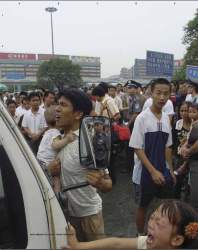
BEIJING, June 9, — Authorities in Chongyi County, Jiangxi Province, seized seven beggars and mental patients and dumped them in a remote place to improve the downtown outlook, the Nanfang Daily reported yesterday.
Five of them are still missing, the newspaper said, adding that the other two returned to Chongyi days after a Civil Affairs Bureau worker and four police assistants dumped them in a remote part of neighboring Dayu County on January 21.
One of the returned victims, a beggar identified as A Liao, said he was sleeping near a supermarket that day when a truck pulled up. Several men got out and forced him onto the vehicle.
The truck stopped after a long drive. During the trip, a civil affairs worker gave them each a pack of biscuits, A Liao said. They forced the seven people off, and turned back, he recalled.
Guo Dongxiang, 61, is one of those missing. She reportedly has been suffering from mental problems for 20-plus years.
Her son, Wu Longsheng, said his mother left home about 3pm that day and never returned.
A bureau official said the civil affairs and public security departments did it to ensure the downtown is free of eyesores as instructed by the county government. “There’s no center for vagrants here, so we handled it as in the past,” the paper quoted a bureau official as saying.
www.chinaview.cn 2005-06-09 10:22:58
The control statement made by the impressive architecture of Beijing West Railway Station is immediately undermined by the presence of semi-permanent inhabitations put together by those who have not been effectively sorted by this power structure. They are not only an eyesore, they are an implicit criticism of the way in which the city’s stratification procedures are operating.
This dream took real-world shape as suburbia: the non-urban retreat for urbanites undergoing anti-urban propulsion. As the family group moved out the city became the fled centre of a residential donut.
The widespread creation of twentieth century suburbia, and in particular that of the popularized American Dream suburb, was made possible by the combination of affordable automobiles, the provision of long-term low-interest mortgages, and cheap modular building materials. It was made desirable by intensely explicitly stratified inner city conditions. At that time the cheapest building typology was extensive low-rise single family homes, and these factors in combination gave a physical definition to that moment of dreaming. It was what the west could find towards achieving incomplete escape from the urbanism it had come to regard as sick. In stark opposition to the city it offered non-collective living and non-collective transport. It was something outside of all that. And it offered individual homes on individual lots of a scale that individuals could either build or conceive of building. There was nothing visibly greater than themselves. If the city had instigated itself on the principles of gathering and sorting, impressive physical manifestations of power, and complex structures of access and hiddenness, the suburb struck back with dispersal, long ranges of low monotony, and streets which led on to nowhere at all, or to simple factual dead ends. Unlike the stratified city the suburb was composed of segregated homogenous communities. It was a spatial illusion of equality, with the continuous grain and exclusiveness that the disrupted urban condition was failing to supply. As a spatial entity it offered an abnegation of the balance of urban imperatives, but did so without providing a move towards something qualitatively different. It offered none of the rural attributes of self-sufficiency or open land or the unification of work and home. It could neither make sense on its own nor be a continuous part of something else. Instead it was the product of a series of denials — a movement away without moving towards. The dreaminess from which it stemmed did not produce a specific alternative. Rather it created something neither city nor country; but a place none the less, and one defined by the act of trying to get away. It was the creation of an abtopia*.
the suburb as the spatial illusion of equality
郊区给人以平等的幻觉
However, for all it is reviled it is notable that abtopia* or the suburb as we know it has reproduced itself everywhere upon the instant that circumstances have made it possible. Biologically it is highly successful, and hardy. Moreover the service-forms that have developed to nourish it have gone on to become the global chains whose products the world most wants to buy. Its predilection for long-range shopping in malls and fast-food eating beside parking lots has shaped the landscape of the world’s goods. Nor has it been without its utopian proponents — those who seek the ideal balance of its lawns and leafiness and its connection to urban benefits. But it has applied an enormous pressure upon extant urban tissue, and though cheap to build it has expensive ramifications. It is grossly inefficient in terms of land use, building materials, and heat consumption. Utilities and infrastructure have to be run over great distances to each individual house. There are large new precincts to police. Thousands of lonely streetlamps, burning deep into the empty night. Disaffected green men offering crossings to no one to nowhere. And most famously it has invented the traffic jam. Building itself frequently at densities too low to support public transport systems, and imposing long commutes upon its inhabitants, it combusts cubic kilometers of fossil fuels for its residents to move at speeds less than that of a bicycle.
The suburb has sprung from the paradoxical desire both to be in the city and not to be in the city, and has forced both planners and real estate developers into the most hopeless contusions of rhetoric. Attempts to integrate the suburb into the urban tissue meet the continuous contradiction of ideals which lie at the root of the two forms: the abtopia* suburban urge produced by the dystopic interpretation of the city. The abtopia* will by necessity try not to be a part of the thing which it is in fact extending. It is a dream of self-denial which cannot give itself up. The current conditions of urbanism in China are deeply stratified and densely packed with unplanned disruptions, and thus create an ideal bed for dreams of abtopia*. The new wealth coming in and the rapid expansion of the middle class ensure that these dreams will find themselves spatial expressions: the real estate will be built. The question remains of what forms these dreams will build this time — what are the defining factors which will determine the physical manifestations of an idea which is only a movement away from place? That the Chinese are dreaming, and dreaming of abtopia* is apparent. The following is a translation of an advertisement for Fortune Island, a residential development between the fourth and fifth ring roads of Beijing.
Fortune Island, an exotic name which reminds people of the mystery of the tree of Buddha, or the scent of the small banana tree, or beautiful girls in coconut bras and grass skirts. Being the most prestigious townhouse project in Beijing, after the noble first project, the refreshing second and the novel third, Jade City adopted this new water-view design for its fifth project, Fortune Island, which brings a breeze of oriental romance to the whole real-estate project.
beautiful girls in coconut bras and grass skirts
It sounds like the most remote idyll in the world, casually dropped into its fastest growing capital city.
The Chinese residential urban development, or chiburb*
Dreaming of soft clouds off a pillow of solid rock
Lee Garden Service Apartments Beijing, Oxygen Bar: Following sportive activities or just to regenerate what better than pure oxygen? Here in a warm atmosphere and some light music guests can relax absorbing pure oxygen.
When I stepped off the plane in Beijing in March there was a strong wind. It was blowing right across me. I hadn’t slept for maybe 30 hours — throughout the flight an argument I’d had with my girlfriend before leaving was going round and round inside. I think I’d exhausted my fury long before, and from then on in it had been just swirl. I came down the steps and on the concrete turned to look out at Beijing. I could see only a gradient of dust and distant cranes. The wind blowing at them. On the bus on the way to the main terminal we all stood looking south as the wings went tapering by, and nose-cones and semaphore-men, all of us looking for Beijing. Beyond only ever the gradient of dust, and the looming of distant cranes.
The level of pollution in Beijing is really something else. There are emissions, but it’s more the airborne particles you feel — some of them wind-driven all the way from Mongolia, some the construction dust of city itself. Everyday I’d cycle home and pull the gunk from my eyes, stand and listen to myself breathe. Feel a screw somewhere tightening. One time I saw them demolish a three-storey building simply by punching holes round the base and standing back. It collapsed and threw a huge cloud up and across the Dongzhimennei Dajie, just south of the Lama Temple. You can go round the CBD anytime you like and write your name with your finger on the windows of brand new glass skyscrapers. They say they’re going to have to do something about it by 2008 or it’ll be the slowest Olympics on record. They say there’ll be marathon runners stopping by the side of the road, holding onto their lungs.
DU[OXYGEN]ST
Beijing is extremely dry and dusty and noisy and polluted, and real-estate marketing has responded to this with promises of reversal. If the existing urban condition has immediate harsh qualities then the easiest form of allure is to offer their opposites: the verdant, the tranquil, the cut-out of green space within which urbanism stops. The new residential developments in Beijing are literally fenced off from the world around them — walled and guarded enclaves of non-city in the city, sudden tropical islands in all that concrete dust and beeping. By expressing a series of denials of the new private blocks hope to meet the inhabitants’ dreams of abtopia*, and thus become the form for the Chinese suburb. They are examples of how urban program may be reformatted to sell to anti-urban demand.
Historical factors in China add further lacquer to the suburban ideal. The move into a private suburb-home is not only one away from the noisome city, but also away from former communist collectivism. The suburban family home is the runaway antithesis of the Maoist danwei* (where husband, wife and children were accommodated separately, and meals were organized according to worker-groups and eaten in canteens). The isolationary aspect suburbia is elsewhere accused of can in China be the soft cloud dreamt of off the pillows of worker-dormitories. It is freedom from physical or societal megastructures. It is a clear statement of property ownership and a point of independence from controlled city objectives. It is a rebuttal of industry dominated landscapes, and the divide it enables between work and living space highlights the new individualism. It is its own thing.
However, the real estate market in China is not that of the 1950s in the west, and the cheapest typology is no longer extensive low-rise abtopia*. The suburban dream as it manifested itself in the US was determined by personal cars and long reaches of cheap land around smaller cities. In China however the city is already vast, and lack of land and the complications around securing it from the government make it an expensive concern. Moreover there is the problem of what kinds of projects the government will be prepared to back. On the other hand cheap labor and advancements in technology have significantly brought down the cost of constructing multiple storey buildings. These conditions make high-rise inevitable, and thus the private developer is caught in a bind: he has to build towers, and sell them as suburban living. It’s a ludicrous position, giving rise to the ludicrous presentation of Fortune Island. The residential enclave does not try to be part of the city but apart from the city, does not try to interact with its surrounding environment but seal itself off and sear its interior of urban qualities. They are isolationist building projects whose priority is the exclusion of the city rather than their place within it. The multiple storey blocks create an anxiety of association with the tissue they are trying to reject, and thus produce a more extreme reaction against it. They proclaim themselves to be HIGH in all things nonurban while being LOW in all things urban. They are like standing soup cans, perfectly enclosed, wearing proud health labels. Their non-interaction with the city is expressed by a radical unconcern with related services, or the infrastructural implications of putting those people there. The residential enclave forms itself around the desire for abtopia*, and worries less and less about physical realities. Indeed as an increasing percentage of the apartments are presold, before construction is complete or sometimes even begun, its obligation to worry about physical realities is greatly diminished. It can be profitable purely at the proposal level, and subsequent construction is cheap. It becomes almost a concept product, where the built form is secondary. The brochure is more important than the development’s concrete existence in the city. The design is more about feel or style than actual form or function. The project is no longer directed toward urban growth, but toward selling an idea of suburbia. It is about producing advertising materials which carry the sense of clean air, space, quiet, tranquility, without necessarily achieving them. They become exercises in illusion. Rich green lawns from genuinely tropical places are cut and pasted into the marketing images. The tower facades are colorfully tiled to create contrast from the typologically similar concrete monotonies of communist era block-building. The congested grid of physical Beijing is rejected in favour of little windy lanes within. The developments associate themselves with abstract qualities — fortune, royalty, romance — and companion non-places — paradise, dream-house.
Some titles given to Beijing chiburb* developments
Fortune Island
Chateau Regency
Fragrance Park
King’s Garden Villas
Natural City
Silver Lake Villas
Le Leman Lake Villas
Lee Garden Apartments
Somerset Fortune Garden
real estate becomes a concept product, where the built form is secondary
房地产已成为概念化商品,形式相对次要
In Beijing I lived in a residential enclave of twelve twenty storey towers in the Chaoyang District. They were bright and tiled with blue and pink stripes, looking less like a forest of chimneys than a line of standing sweets. There were two gates, both of them guarded. Vehicle entry was via the south-east gate, off a minor road, from which you passed along a one-way street and round a roundabout to exit through the west gate onto the Jiuxianqiao Lu, a major road. By denying vehicle access at the major access point — i.e. the Jiuxianqiao Lu — the system cleverly minimised through-traffic. Inhabitants would generally pass in or out on foot, and transportation by car would occur only once outside the compound. In this way even though the compound was, infrastructurally, very much car-dependent, relatively few cars ever drove through. It retained the feel of being traffic-free, while contributing significantly to the traffic problem on the Jiuxianqiao Lu. Obviously the noises heard and the air breathed were the same on either side of the wall, and were no doubt worse than before the enclave was built and all that extra traffic created. However inside the wall you had the feeling that traffic was a problem that existed outside. It was a Chinese suburb-style illusion.
there is no such thing as urban nonurbia
But the most interesting thing about the road system didn’t strike me until I had been living there for several weeks. It was not the one way system but the roundabout. A roundabout with one entry and one exit on a one-way street is, I realised, completely meaningless. If there is only one direction of flow there is nothing for a traffic system to negotiate. You can go one way round the roundabout or the other it makes no difference, but you can’t meet anything else on it. The other cars can only ever be behind you. And so what was it doing there? It took up a considerable amount of space — there was the band of road all the way round and in the centre a circle of sparse dry grass several metres wide. Moreover it cut a much larger space between the two groups of towers into two, leaving odd offcuts on either side. Because both of these were always near the road they were of low recreational value, and thus although there was a sense of space, there was very little usable space. The fact that the space wasn’t really usable, and that there was seldom traffic on the roundabout, ensured that it was generally empty, and so it gave off an impression of low density, tranquil, quiet and so on. The same was true of other spaces between the towers. But not only did the roundabout suck up an otherwise potentially populated space, it created a curvy street. While serving no traffic function, it promoted the illusion of slow village-style suburbia, where winding roads come together at a small roundabout beside a green.
In Beijing the paradoxical tensions within suburbia-desire have reached new extremes, and have snapped out in expressions of overt oxy-moron. It is like pressing the north ends of two magnets together. There is no such thing as urban nonurbia, as residential settings which are inimical to public transport and free of the blocked arterials they exacerbate, as non-self-sufficient moments of pure enclosure, as program which does not relate to the city it is dependent upon. These dreams of soft clouds need the roads and services and employment they shun. They need the collective aspects of the capital they deny. They are inevitably connected to the solid rock which has produced them. Chinese urban abtopia** is taking shape as a string of disconnected high-rise enclosures with suburbia-illusions whose real world effects are the deterioration of external urban quality and the provision of a senseless internal peace. This is the current look of the chiburb*. It is astonishing that the most rapid urban growth the world has ever seen is taking place while being conceptually at odds with urbanism itself. Moreover it is at odds with the urban reality it is creating.
As with other forms of abtopia** the chiburb*, within its guarded limited pockets, is mostly unstratified. It mostly represents a single higher income bracket. The construction of permanent real estate in China is being managed chiefly by private developers, whose interest is necessarily in profitable ventures. They will bend form and suppress function in order to attract available capital, which is concentrated in a new but narrow middle class. This class is the dreaming lung behind the real estate bubble. It is composed of those looking to buy apartments in which to escape the city with its harsh conditions and density of sense-offending outbreaks. However the concentration of capital is a poor representation of housing demand. The majority of people seeking accommodation in the city over the next twenty years and hoping to be sensefully stratified will be rural migrants. They are a small proportion of the capital available for real-estate projects, but a great many bodies. At present many are housed in prefabricated dormitories on construction sites or near factories, in the restaurants, shops and brothels where they work, or in patchwork slum-type dwellings in peripheral villages. They are given no special place in the dream, but if they are to be included in the city some planning will need to be done for them.
I remember in June cycling along parallel to the construction site where they are extending the Beijing Airport Expressway. They were digging pillar foundations, and points for a tree-lining. Every twenty metres or so there was a migrant digging a hole in the dust, wearing blue factory trousers and light black plimsoles. Squinting, sweating. The handles of their spades were raw tree branches stripped of bark, and the heads popped out of a thin steel sheet. The heads were heart-shaped, with a pressed central channel for reinforcement, and a stem where you stuck the tree branch in. So these migrants in their bare chests were digging holes in the dust in the brute sun as cars went flashing by. And me on a bicycle. For the elevated airport expressway. “Wow,” I said to myself. It’s just like the building of a Great Wall.
The Chinese urban fabric
The City of Zero Liminality* and Real Sub-urbia*
At the same time the city is having to consider how to house its stratified dreamers, it is coming to terms with another of its most natural products — that of congestion. The drive to gather, to concentrate, to control, and to allow certain routes of access by necessity involves larger numbers of people trying to get in and out of a smaller number of places. It is an implicit condition of interrelated areas of different densities — an implicit condition of urbanism itself. Developments in telecommunications have obviated the need for certain trips, and yet have occasioned the grounds for many more, and often longer. Moreover recent shifts in lifestyle and employment practices have led to more frequent changes of living and work places. The two are now much less likely to be closely related, and the modern urbanite will regard an easy route to work as a piece of rare felicity rather than a basis for where to work or live. Especially as the work-places themselves have been moving too: — with the growing expense of central locations many companies have chosen to relocate further out. Decentralised developments in turn generate more decentralised activity, and increasingly even routes between non-central locations see rush hours. As urban growth and unpredictable movement patterns independently accelerate their collecting intensities, the transport system finds itself inundated with more people wanting to move further more frequently in more diverse directions. For this the automobile is ideal. It is fast, instantly available, and independently directable. However, while travelers on foot demanded perhaps 0.5m2 of circulation area each, once in cars they need at least 10m2, and much more if they are to move at any speed. Suddenly the streets are over twenty times too small, and horrifically congested. The city’s power to gather and sort is hit, as is the sense of control. Axial processions and grand buildings lose the aspect of being greater-than-the-individual as a group of individuals have brought their systems to a standstill. Suddenly facing the equivalent of a stroke the city is forced to rebuild itself at lower densities on a larger scale with wider access routes. The spacing out of things alleviates certain high-points of pressure but increases distances. Nobody would think to walk to work anymore, and besides, the streets have become roads. They are noisy and dangerous and difficult to cross. Moving along them other than by car becomes unappealing, and increasingly the experience of travel is characterised by stepping out of a work or living or service space and into a taxi or car park. The areas around things begins to deteriorate, and the desire to pass through it diminishes. The difficulty involved in making a series of stops at different locations and the disinclination around having to walk between them favours mono-destination shopping. These are large-scale non-local amassments and lead to the closure of many more local service providers. Linear arrangements of shops and restaurants fall into decay as business moves to bigger more distant centres behind vast parking lots. And so a further class of urban trip is motorised and starts to apply pressure to a wider area of road-space. The roads are scaled up again to support supply networks to the service centres. Although the costs of all this extra road building and car use are transferred to the inhabitant in tax and health problems, the size of the big goods marts and the volume of their sales allow them to lower their own product prices. Seeing this the inhabitant is delighted with progress. He sees immediately how visible expenses have been shaved down and feels he is getting bigger bananas for less money. As he drives back through the local area vacant shop fronts create a sense of disuse, and it seems even a little threatening. Certainly dirty, and poorly maintained …. There are odd outbreaks, or eyesores, and the swirling litter associated with them. Perhaps someone is selling peppers on a smutched cloth or newspaper; their green skins alternately dark with exhaust grease, and pale with dust driven up from unfinished sections of the road. Nice inhabitants do not wish to be found along here, or standing at the bus stop. Rather they hole themselves up in residential developments. They build walls. The rest of the shops outside give way to the wasteland and bus services are cancelled. Families keep their children in, except when they take them out to somewhere else. With the complete abandonment of the local the city is forced to compartmentalise itself. This place here for this one thing; here living, here shopping, here paying park …. Each compartment is independently sealed. Everyone who can is now living in a chiburbs* to get away from the roads, the outbreaks, the pollution. Besides, with the demise of both continuity and locality there is nothing outside left to be lost. The separation of use-areas means more long trips are required in and out of distant destinations. The scale is further exaggerated, and city-travel by anything other than car becomes impossible. Even the widened roads are now stressed, and have to be upgraded again. This time with people regularly driving 20km or more it is necessary to build systems which facilitate higher velocities. They make the leap to six lane arterials, and in between what were once capillaries of public streets are swallowed up into private development – chiburbs*, business parks, megamalls, etc. The arterials cut through the city with sheet walls to either side. There is no longer such a thing as the crossroads; only flyovers, slip lanes, stacked junctions, asphalt clovers. They move onto twins of concrete pillars and cease to have any contact with the program they pass by. Buildings formerly along their routes shift back, retreating from their drone and foulness and leaving them to run down evacuated corridors. They become long strings through nothingness. Stopping once and standing back to look at them, trying to imagine where he grew up, the chiburbs* is aghast at their scale; terrorised by the speed of things passing. Being so small and soft he has no way to negotiate such structures and so is forced to give them up. He looks around once (the vibrations are numbing his sense of touch). Only blank spaces echo darkly. And was there something moving in there? He returns to his vehicle. There is a plastic bag rucked against the front tyre. The in between parts of the city have ceased to exist for him. He closes his door. They’ve been sucked away. Instead experience of the city is a sequence of sealed environments. The chiburbs* goes from one specific location to the next via a car interior. Throughout he maintains his own atmosphere. There is no contact with the transition — with the city itself. There is only a time gap. From room to elevator to car seat to elevator to room. The idea that things are connected in space is a purely conceptual concern. It can represent costs, but has no physical reality into which a chiburbs* can fit. The city has become a solitaire board — a discrete number of positions. In this model the marbles can sit in any one of the dimples but in between is impossible. The in between space has all been flattened, and is hard. The solitaire board city is a City of Zero Liminality*.
However, as the chiburbs* progressively cedes liminal space, it is increasingly taken over by those left unassimilated by chiburban* grain. While the city rebuilds itself in highway concatenations of exclusive walled enclosures, those who are being excluded are forced to take up residence among the leftovers. Unable to participate in a city which has transferred itself entirely to delineated abtopias*, they form a parallel city in its abandoned zones. Under the hardtop, in between the dimples. This is the Real Sub-urbia*, existing literally beneath the urban area, under its transport structures, finding shelter among the concrete legs. There is the top-level urban scheme, and beneath it this second sub-urban inhabitation. Without the economic means to travel by car and in a city where public transport has evaporated, the real suburbanites situate themselves wherever there is work, in temporary dwellings which shuffle along behind sites of temporary labour. As each new arterial is built it draws along shanty towns of migrant construction workers, living at the head of its shadow. Liminal villages go up and disappear as new chiburbs* are undertaken and then completed. The areas beneath flyovers become the kitchens and bike shops of Real Sub-urbia* — their burners troughs of discarded steel; their wash water run off the road. New hutongs spring up among the weeds surrounding concrete spaghetti junctions, and laundry lines are strung between the safety barriers. The sheltered avenue below an elevated highway is the site of a linear market. Real Sub-urbia* is the dark strata beneath the City of Zero Liminality*.
The City of Zero Liminality* and Real Sub-urbia* together are the crudest possible expression of the city’s stratifying urge. There is no attempt made to justify or unfold itself. Nothing is either shown or hidden — it is only either part of your city or not according to in which chiburb*]] or under which concrete stack you live. Those parts which are alternately given over or totally inaccessible have no relevant existence. There is no inter-relation. There is no sense to any of it as a whole. In a way the entire entity is a series of disruptions to the sense that was once there. What is left is a set of stratified locations. No integrated planning has been done for it. It is simply nakedly abjectly there.
Two Ways to Urban Plan
abstract visionary—organic emergence
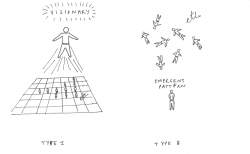
TYPE I: ABSTRACT VISIONARY
everyone is identical to each other but not to the planner, who is pre-eminent
TYPE II: ORGANIC EMERGENCE
everyone is a planner, being encouraged into flight
TYPE I: The harmonious city must first be planned by experts who understand the science of urbanism. They work out their plans in total freedom ... once their plans are formulated they must be implemented without oppositions
—Le Corbusier
TYPE II: Perhaps the most powerful way of improving the fit of our environment, however, is to put the control of it in the hands of its immediate users, who have the stake and the knowledge to make it function well. If users are in control ... then a good match is more likely.
—Kevin Lynch
There are essentially two strains of urban planning. There are two ways of thinking about it, and all schemes and policies at heart emanate from one or the other. They are indicative of two almost pre-conscious positions about the nature of the human being. The first is a belief in expertise and the power of ideas. Type I urban planning is confident of man’s dominance over nature and therefore allows itself to take place in abstract fields. It believes that the key concerns of collective living can be assimilated into the world of thought, reorganised, and then put back into the natural world. It believes that city-dwellers’ needs and desires compose a single body of information which the planner, through diligence and specialist knowledge, is able to comprehend, and turn into rational data. With strong thinking the planner is then able to perform operations upon that data, and consequently to construct appropriate schemes for those people. Because of the planner’s diligence, specialism, and capacity for strong thought, he will provide better systems for those people than they would for themselves. He will have derived the correct forms. Type I approaches maintain that man is capable of large-scale thought and mass organisation. Indeed it is Type I’s belief that man’s ability to think in the abstract is his special attribute — is what sets him apart from the natural world and gives him dominance over it. In this way Type I approaches often have transcendental resonances. They lend themselves to bigness and to visionary projects.
Type II thinking distrusts this grandiosity, and will reject attempts made to dissociate man from his immediate environment. Type II planners believe that the source of man’s genius is his ability to adapt to his surroundings, and to adapt his surroundings to him. Man is at his best acting among the circumstances in which he finds himself. His best ideas are creative responses to specific conditions. Abstraction will fail to net the complexities of a real world situation — will often forget some huge and vital component — and so will create weirdly incongruous propositions, or universal answers hopelessly misapplied. Not only will abstraction blank local problems, it will miss the chance to exploit local advantages. According to this way of thinking there are no correct forms, only individual solutions. Those best fitted to do the solving are those actually in direct contact with the individual environments. Rather than believing in lone experts, Type II planning places faith in localised creative ingenuity. People, with their superior understanding of their own desires and needs, and their true contact with where they are, will sort out their own housing better than rarefied planners. The Type II planner’s role is more to facilitate this process, regulate it where necessary, and occasionally if required perform conservative surgery. In this way Type II approaches tend to be less visionary, and lean more towards multiple smaller cellular projects.
These two modes of thought about urban planning align themselves fairly swiftly with certain movements in the history of ideas, certain forms of government, and certain urban typologies. The scope of Type I-style schemes requires strong centralised power structures confident of their ability to execute, and imbued with a degree of visionary zeal. They will be keen on technological advancements and the idea of progress, and will favour geometrical forms and long clean lines. There will be a slight inhumanity to the schemes, or of an idea of highly ordered collective living — something like a beehive or an ant hill. Its vogues have included the Renaissance, in the new delight in mathematical progressions; the colonial city; the post-war applications of modernism — especially in the Soviet Block — when people were full of big ideas; and Maoist China (though here with greater focus on agrarian-industrial settlements than on cities). Type II thinking has associated itself more with the Garden City, Broadacre City, Victorian Romanticism in Britain (though not in its colonies), the American Dream, and recent trends focusing on cultural studies and the regeneration of the local. Rather than governmental intrusion it favours private development, and market-management via zoning and infrastructural layout. It takes the market to be a practical rather than theoretical representation of people’s needs and desires. While the collectivist thinking of experts and visionaries has most often stacked people in towers, the individualist decisions of people themselves have been more often towards individual houses on individual plots of land. The twentieth century has frequently set the Type II suburb-home with its own little garden against the Type I Le Corbusian parkland of towers.
What is most striking about both these ways of thinking is the intense alienation that is associated with their two most natural recent expressions. While trying their hardest to please, Type I and Type II planning initiatives have met hard rain, and their attempts to force the city’s stratifying operations to make sense have most often resulted in very divided environments. They have produced landscapes of frozen islands which have been heavily criticised. However relatively few cities stand dominated by one to the exclusion of the other, and most are composed of a variety of typologies and historical directives. Neither way of thinking has achieved a method which is widely applied without regret, and more often it is matter of tendencies.
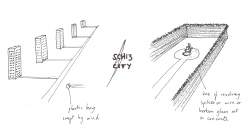
LANDSCAPES OF FROZEN ISLANDS: two famously alienating environments often found side by side
The current feel of China is toward Type II. Deng Xiaoping’s dictum “Learn from facts” is a clear kick against grand interventionist policy, and toward a less visionary approach. It is toward a Type II style indeterminacy and faith in low-level opportunism. Let things come to exist, and its users will pass judgment, it proclaims. Learning from facts can be seeing what people build and buy, how the market behaves and the city develops, and perhaps only guiding as required. This suits the current policy of economic advancement through market capitalism, and the celebrated Chinese aptitude for entrepreneurialism. However the scale and speed at which urbanization is happening in China is in a sense inimical to the notions of local involvement and organic emergence upon which such an ideology is based. While the developments are directed by private interests, they are a long way from being expressions of private individuals with a strong sense of the area being developed. The somewhat anarchic ideal of groups of liberated individuals taking the city into their own hands and building for themselves is rather lost in the gigantisms of private developers building blocks for upwards of 3000 people. What happens is that the essential principle which would guide such planning strategies — i.e. the representation of local interests via their direct participation — is lost, while the sense that planning on a bigger scale is no longer necessary, is retained. There is still the appealing liberation from high-level abstract interventionist policy, while the counter-idea of low-level input from experienced users is swallowed up. Type I planner-thinking is carefully avoided, while the basic collaborative elements of Type II planner-thinking are excluded from the process. In effect it comes closer to being a policy of no planning at all. It has been devolved away from top-down planners and yet scaled out of the reach of bottom-up planners. Thus in China we see the rather puzzling situation of Type I style building projects being produced under Type II style management. The chiburb* developments are very much Le Corbusian towers in parkland, and yet there is no expert formulating their position in the city or their integration into its fabric. Equally there is no process of organic emergence by which the chiburb* inhabitants integrate the development themselves by the process of using it. They are simply all moved in there at once after the thing is built. The scale of the chiburb* ensures that it is abstracted from the direct expression of local interests, and yet it has no abstract visionary plan into which it takes its place.
The somewhat anarchic ideal of groups of liberated individuals taking the city into their own hands and building for themselves is rather lost in the giganticism of private developers building blocks for upwards of 3,000 people
当开发商纷纷要建超过3000人居住的小区时,那些有点儿无政府主义的自由主义分子试图掌控城市命脉、按他们的想法建造城市的理想则被“大”淹没了。
Equally the City of Zero Liminality*, with the loss of its transitional areas and the creation of its dark twin Real Sub-urbia*, come about as a Type II phenomenon. There is no emanating abstract expert insisting on this form; instead it emerges organically as individuals make decisions, and the city makes responses. There is a simple low-level abstraction of the process of transport, when people decide to remove themselves from the city and get into cars when going from one place to another; and there is a residential abstraction taking place as people move into chiburbs*. The subsequent scaling up of roads is only what “conservative surgery” Type II planners are able to perform. The separation of use-areas and the deterioration of transitional tissue all follow quite naturally. And yet again its ultimate form — its bigness, its inhumanity, its clear formal divides — look more like the product of Type I visionary (if dystopic) thinking. Looking at it, it is much harder to believe that people actually in situ would build for themselves such manifestly unfriendly forms, and abnegate so completely their local environments. The space has been collectively abstracted, even though there has been no centralised abstracting mechanism to make that happen. It has come about as systems are built which allow local residents, who under Type II schemes should be the local planners, to abstract themselves from the processes of their urban environment, and that urban environment then rapidly becomes abstract to them. Actions which in their collected mass determine how the urban situation develops itself, are on the individual level the single acts of inhabitants removing themselves from the city, and getting into chiburbs* and cars. City-wide this translates into the city rebuilding itself with such swiftness and on such a scale that it is soon impossible to relate it to anything the inhabitants had ever thought of or could recognize. The city as they last saw it disappeared behind their backs.
Carol Xiao, with whom I wandered the streets of Sanlitun at night, once told me about coming home to Beijing after six months in New York. They had been building the fourth ring road at that time, and a new section of it now cut through the area near where she had always lived. She passed beneath the highway and looked around, somewhat confused. There were grey roads curving down and quadrants of leftovers from the demolition. Cars were passing overhead. She picked her bag up again and walked on, but found she couldn’t find her way home. Quite literally. She couldn’t find her way home. She just didn’t know what things looked like anymore.
The City of Zero Liminality* as the Chinese Dream?
The chiburban* inhabitants of the City of Zero Liminality* — i.e. its upper strata — simply do not experience it at all. While there is lots of movement, there is no spatial aspect to the program between departure and arrival points. The transit occurs, but without the city’s involvement. In the meantime the lower strata are not able to move at all, having been excluded from the transportation network by not having access to a vehicle. For either group the city becomes only its static positions, and is experienced as a static collective. Without the passage of people the once continuous urban fabric starts to disintegrate, and already the city is losing itself. There is stratified gatheredness, but all separated out. Everything is greater-than-the-individual but with no collective focus. There is unilateral access and exclusion but with no city component to it. There is no point at which the city is showing itself: there is no display, nor it there a temporal unfolding of its environments. The low-level abstraction processes of abtopia* desire and widespread use of the motor car in conjunction with Type II planning approaches of an inappropriate scale have led to an excess of hiding. Exclusion becomes the dominant feature of such a city — people the city excludes and areas which the city is excluded from. If it is to maintain itself, the city must maintain the contact between its inhabitants and the urban fabric. It must maintain its role in acts of transportation, and must have transitional areas. For if the stratification of the city is to make sense, it must be able to relate its different levels to each other in space. If you can live in a city without being aware of it you cannot interact with its organization.
And it is through transport — through moving through the city — that such an interaction occurs. The transitional area within the city is the space for dynamic possibility and the notion of unplannedness — for the creative use of particular local spaces which Type II systems pride themselves upon. While the two points and the movement between them is planned, the exposure that occurs during that movement is what the local can exploit. It gives the movement — and thus the city — the quality of being dynamic. Going from one place to the other is full of the potential for unplanned interactions. You see things you were not consciously looking for, and become aware of the gatheredness of the city and the nature of its gathering. The city is speaking itself as you travel through it. The transitional areas are where the city can express an identity — a sense of place and itself — and maximize the accessibility of random urban experience. In this way the city profits from its initial function of stratified gathering. Contact between the city and a car is the collision of two environments, whereas on foot it is the unfolding of one. In the dynamic city everything is fascinating — every movement through the city is loaded with exposure, unpredictability, creative potentials. It is about the fertility of linear access routes rather than their destinations. And transitional tissue is important not only between departure and arrival points, but equally across each transition. Each change offers the potential for dynamic quality: from apartment to leaving the building, from building to public street, from street to public transport to service centre and so on. Hard borders such as walls and gates provide little space for possibility and themselves can be intimidating and discourage entry. But soft borders offer moments in which to experience the change in environment, and to linger between states. Movement becomes a dynamic series rather than a transposition from one point to another. Traveling through the city there is no longer a painful feeling of unnaturalness; instead there is a process making sense.
Both congestion and stratification are conditions of urbanism. They cannot be solved at the city-wide level — there can only be enclaves of their inexistence, which transfer the pressure elsewhere. These enclaves can be regarded as non-urban contributors to urban stress, or interruptions in the dynamic flow. How strong the stratification itself is and how distant its extremes are not things that can be controlled by urban planning. Societal reform is as much a part of dealing with unplanned disruptions or outbreaks as better zoning is. However the way in which a society’s stratification expresses itself and even develops is closely related to the urban forms it takes. For a society itself to be dynamic it must ensure a spatial relationship between its stratified bands. The current conditions for dreaming in China, and the reliance upon Type II planning when the urbanisation is happening so fast, is leading toward a City of Zero Liminality* with an underclutter of Real Sub-urbia*. To avoid this progression some shift in approach is required.
And so what is the alternative? A complete move to visionary planning is not at this stage in China’s development conceivable, or even desirable. However a degree of integrated larger thinking — an adjustment of tendencies in the direction of Type I approaches — is already occurring. The government is strong and centralised and equipped with considerable powers of execution. It already owns all of the land and is therefore necessarily involved on a partnership level with all private developments. Beijing is currently rebuilding itself almost anew from the dust, and given the strength of economic growth and the concentration of power, is capable of doing so in any number of different ways. One version of events is the untrammeled continuation of Business As Usual*. But it will be the government’s growing role in the public-private partnerships which will be able offer a different future. Their involvement, not only through zoning and regulations and approval, but also actively in the fields of market steering and planning initiatives will be able to negotiate the planning vacuum between top-down and bottom-up approaches. They will be able to bring a coordinating perspective onto the different developments, and stratified groups, and their inter-relation. It will be their role to ensure that urban conditions sustain dynamic transitional tissue which its inhabitants continue to move through. While being able to think on the abstract level themselves, their citizens will remain grounded. It will be the wider concerns brought into the partnership by the government which will curb illusory abtopic* projects, and hold the city together through the development of meaningful transitional space. Such a partnership will build low cost housing as well as high, and maintain shared access routes. It will make the dream make sense.
--In the dynamic city everything is fascinating — every movement is loaded with exposure, unpredictability and creative potentials
--互动城市的一切都绝妙无比——每一瞬间都充满了新鲜、不可知和创新的无限可能
=========
Glossary Terms
abtopia a place whose primary and defining quality is that of not being somewhere else. —adj. abtopic [L. abs, away from, Gr. topos, place]
chiburb a residential urban development in China, esp. one which seeks to offer “suburban” qualities while maintaining density and locating itself within a dense urban environment. —adj. chiburban, n. chiburbanite, one who lives in a chiburb [Chinese, suburb]
city of zero liminality a city in which there is no experience of transitional tissue — only locations, departures, arrivals, time lost in transit. In a city of zero liminality, the points at which things start and stop have no thickness. The thresholds have no depth, in fact do not exist. [L. limen, -inis, threshold]
real sub-urbia parts of the city used, often illicitly, as residential areas which, while being cartographically within the urban core, are physically beneath the dominant program, —e.g. a shanty town underneath a flyover, or in the basement of a mall or tower block. [L. sub, under, urbs, a city] “Hey fuck where’d the city go?”
abstract dreaming/pouring concrete
by Adrian Hornsby
Owned by neville mars / Added by Stephanie Yao / 17.8 years ago / 115398 hits / 7 hours view time
Tags
Latest Entries
Contribute
Login to post an entry to this node.
